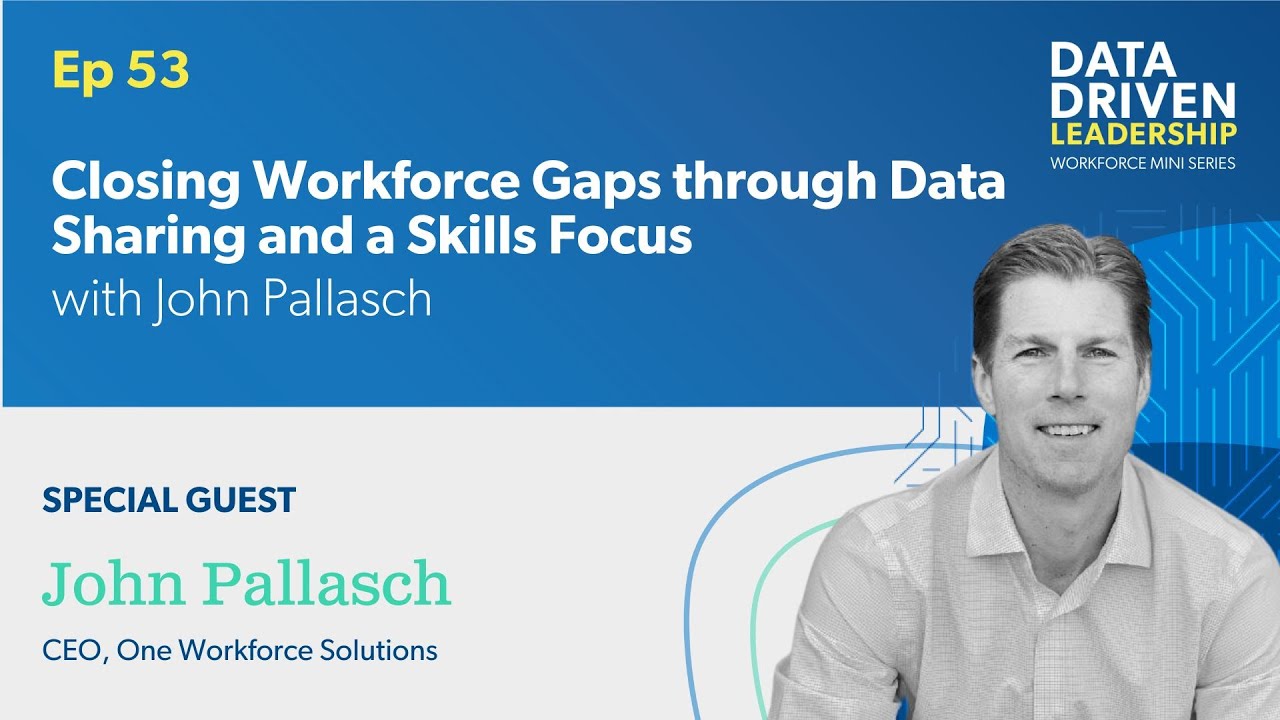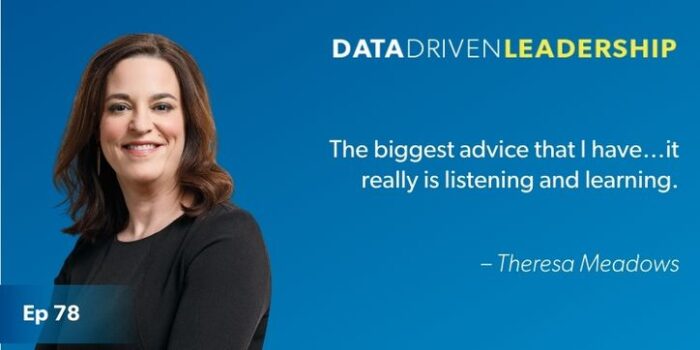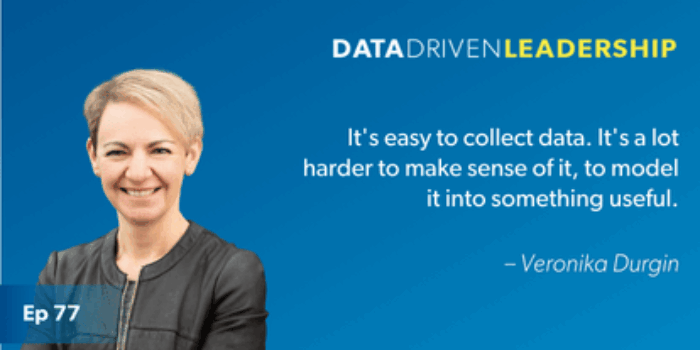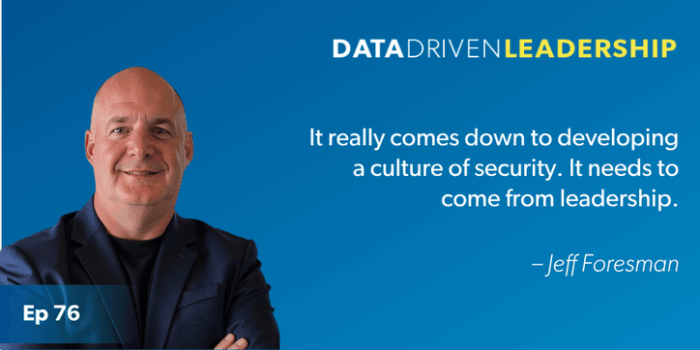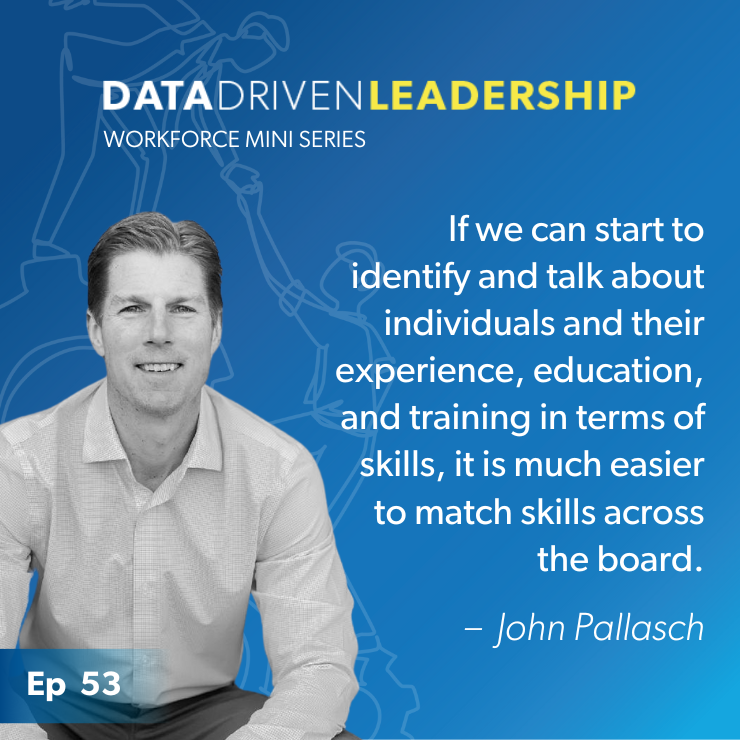
Closing Workforce Gaps through Data Sharing and a Skills Focus with John Pallasch
Make a difference for citizens, employers, and communities with advanced technology and data tools. Learn more about our workforce services.

Transcript
Michael Schmierer [00:00:00]:
Why do workforce development efforts often feel fragmented and siloed? What if we could revolutionize the way we develop and support our workforce using data and technology to bridge skills gaps and drive economic growth? As director of workforce and economic development here at Resultant, these are the questions that I ask myself frequently, which is why we're here.
I'm Michael Schmierer, and this is my takeover of Data-Driven Leadership. In this four-episode miniseries, I'll be joined by several industry experts as we discuss how data and technology can transform workforce systems, enhance job matching, and support workforce readiness. The goal is to provide you with valuable insights and practical strategies that can help drive transformational change, inspire action, and foster collaboration among stakeholders. You won't want to miss this. Let's dive in.
Michael Schmierer [00:00:54]:
Hey, guys, this week, we are excited to welcome John Pallasch, founder and CEO of One Workforce Solutions and the former assistant secretary at the United States Department of Labor, overseeing employment and training. John and I's conversation is going to center around one workforce solution. How do we bring together the fragmented pieces of our workforce into a human-centered design where people can seamlessly interact with the different agencies and different programs within the workforce system, enabling them to find the training and find the jobs to get them to economic mobility?
Michael Schmierer [00:01:34]:
John, welcome to the podcast. Excited for our conversation today to talk about kind of the workforce ecosystem as a whole, and maybe some innovative solutions that you have and that you've seen be successful in various states or at the federal level. But, but let's start with the basics, you know, what are the main issues caused by a fragmented workforce system that you see out in states or clients that you work with?
John Pallasch [00:01:59]:
Yeah, so unfortunately, I think it's just a product of government. Oftentimes in government, we like to find a problem and then create a solution by creating a new program or a new office. And over the years, what we've seen, especially in workforce development, is there's always another problem to solve. And what we ended up doing is we keep creating more organizations. And unfortunately at the federal level and at the state level, these various workforce organizations, programs, they live under different cabinets or departments, depending on what a, what a given state calls it. I can speak to you about what happened at the federal government.
John Pallasch [00:02:38]:
So I was at the US Department of Labor, which oversees the Workforce Innovation and Opportunity Act, which is the big workforce, federal workforce program. But across the mall at the Department of Education is the Career and Technical Education, the K-12. Just down the road at Health and Human Services is the Temporary Assistance for Needy Family or TANF program. Further down the road from that at the US Department of Agriculture is the Supplemental Nutrition program, the E&T program, I'm sorry, the Employment and Training program. So you can see just there we've got four federal cabinets that all have workforce development components. And unfortunately, in that type of environment, it's very difficult for those all to be coordinated.
John Pallasch [00:03:22]:
The same thing carries through to the states. They may not all fall under the department of labor. It may fall under the department of commerce or another cabinet-level agency at the state level. But you have that same challenge of workforce programs scattered about. They're all reporting to different bosses. They all have different compliance reporting, they all have different reporting schedules. So, it's just a mishmash of programs that have been stacked on each other. And there's really no thought into how they're all integrated and that, that presents the challenge that we have.
Michael Schmierer [00:03:53]:
Yeah, that's a really good baseline for our listeners there. And, you know, when you think about a citizen interacting with workforce and having to go to multiple different sites potentially to qualify for different programs or to get services, it really is… it's not really designed for the human experience and how someone would go interact with government to get services or the help that they need. Specifically at the state level, can you talk about how state leaders can address some of this stuff and the challenges that they might face in trying to bring this more together?
John Pallasch [00:04:23]:
Yeah, so I think one of the misnomers about workforce development is the power and the ability and the authority that resides within each and every governor. A governor can, if he or she decides, make real impactful change, because as I mentioned, they're responsible for all of those programs, all of those various programs scattered about. And if they as governor decide that they're going to begin to integrate those, they can take the easy step—or relatively easy step—of moving the boxes around on an organization. So they can move offices around, they can consolidate them under one person, but that's only going to get them part of the way there. The next thing they've got to look at is the disparate systems. So each of these programs, especially if it's an annual program funded by the federal government or the state government, it's probably got its own reporting system. It's got its own case management system. It has its own database. So we can move boxes around, but then how do we get those databases to talk to each other?
John Pallasch [00:05:20]:
And how do we start sharing data across? And then the third component is, even if you do that, even if you move the boxes, you put it under one person, You start to push and pull data from the various data systems if you're not changing the policies and the procedures—that is, what the frontline folks in that program are doing, how they interact with the job seeker, the things you've done above that—they're not going to deliver the results you want.
So you've really got to start with the organizational structure. You've got to move to kind of the data. And the technology piece, but then as boring as it sounds, you've really got to move down to the policies and procedures, the handbooks, the manuals, how does the individual who's administering that program, how do they do it? How do they engage with job seekers? What are the questions they're asking? All of those things that are boring and kind of get lost. That's really important as well. So I kind of think of it as those three legs of the stool.
Michael Schmierer [00:06:10]:
That's really good insight. And the data piece can't be—you have to stress that because you can't view a person just as K-12 and then just as workforce. And then just as, you know, a staff TANF program, having that data longitudinally can help not only the individual, but also help inform policy and, you know, lawmakers coming to work every day and trying to maybe solve some of these issues. Can you speak to where you've seen some integrations go well? What states or have you seen, um, a program kind of bring together more and, and serve the customer better?
John Pallasch [00:06:44]:
Yeah. So there's a couple of states, one that I'm currently helping and one that I helped under a previous administration. So we'll start with the previous one. I did some work with the governor's office from Arkansas. So governor Hutchinson at the time, okay. And Arkansas recently released their new workforce strategy. And that's really the culmination of a lot of what they've done in terms of tackling this—both, as I mentioned, from an organizational standpoint, but more so the thing that's really unique about Arkansas is they've tackled the data issue, they've created a state data warehouse. They have a very smart, I believe his chief data officer or deputy data officer, I forget—his name's Robert Magoo, and I feel as though I have to shout him out because of the good work that he's done there in creating this mesh network of these systems. He has all the data sharing agreements in place, he has the ability to push and pull information from the various data systems, which is really helpful as we talk about these different systems, these different programs.
It's really important to know if John interacted with one government workforce program and then came into the office of another. Sounds basic, but John shouldn't start at square one. We should know. Hey, John, we understand you were at X office, whatever program it is, workforce, innovation, opportunity, vocational rehab, whatever it was, you were over there.
John Pallasch [00:08:01]:
They helped you with this. Now can we help you here? Very much. If we think about the electronic health records, it's the same thing. You go to a doctor, they pull up your health record. They don't say, when were you born? Is there any history of cancer in your family? They don't go through all those questions because they have that information. So Arkansas has done a really good job with that data layer currently helping the governor's office in Alabama and governor Ivy's been really aggressive with what they're calling is the talent triad down there. So in addition to the organizational piece, which I mentioned, it's kind of the first piece.
And the easiest piece, candidly, Alabama's really focusing on this talent triad, and they define their talent triad is they've got a credential registry. So how are we tracking the types of learning, the things that people are acquiring when they learn? They've got a skill-based job description generator and kind of an employer portal. So again, starting to think, you know, there's a big movement away from just degrees and thinking about things in terms of how do I acquire skills? What are the skills an employer needs? How do we create a match there? And then the third component of theirs is an exploration tool that they're running through their community colleges.
So bringing that together, you know, that speaks to the technology piece, but it also speaks to that policy and procedure piece that I was talking about. They're really rethinking how they're looking at this problem, how they're identifying the skills that are needed. The skills that individuals have and then really bridging that gap in between.
Michael Schmierer [00:09:24]:
Yeah, those are two really exciting examples. And I like what you talked about with Arkansas, with the ability to see across a person in the different services that they've interacted with. Because then you can start to do some really cool stuff with data science, data analytics, and helping to not only help the person potentially find a job or a training program, but help them relieve other barriers as well.
As we know, there's, you know, multiple barriers to someone going to get training or a job, whether it be child care or transportation. Can you just speak to some of those barriers and potentially how states can, looking at the workforce system holistically, start to knock down some of those barriers so we're providing people with more opportunity.
John Pallasch [00:10:03]:
Yeah, that's really the genesis behind the term one workforce. And I use it as the name of my company kind of in a cheeky way. But it's something that started in Kentucky and really carried over to my time in D.C., was this idea that we as a system need to be thinking about serving one workforce. We can have different programs, we can have vocational rehab, and we can have, you know, the TANF program and all these different workforce programs.
But at the end of the day, we're serving one workforce and the more we can bring those programs together and leverage the types of services—because not every program can provide the same services—but if we start to bundle those services together and take a little bit from this program and a little bit from that program, then we're really serving the full customer.
And this was something we actually formally put out a letter when I was in D.C., myself and my counterpart from health and human services and my counterpart from agriculture, we put out a one workforce letter that spoke to our state partners and said, hey, we here at the federal level agree that there should be some integration, some coordination, and we want to give you permission to do this at the state level, because candidly, the folks at the state level aren't going to take that initiative.
John Pallasch [00:11:15]:
They're not going to do that without the permission of the federal government because that's where their money's coming from. I don't blame them. When I was in Kentucky, I was trying to move in this direction. And the folks at the US Department of Education basically told me back off. They said, listen, this isn't, you know, we run vocational rehab. You don't. So you should just stay away. And I was frustrated. Because at the time I was running the traditional workforce program, and there's a program I mentioned out of the department of education called vocational rehabilitation, and I won't get into the nitty gritty of this, but essentially because of funding levels, vocational rehab has categories.
It's a level of a disability and based upon the amount of funding that the state and the federal government bring to bear. They can serve one, two, three, or four categories. And if they don't have enough money, they have to have what are called closed categories, which means we can't serve those individuals. At the time that I was in Kentucky, they had closed categories.
And I spoke to our folks at the state level in Kentucky, in the voc rehab office. And I said, hey, you have folks in your closed categories who are on a waiting list. Can I please get their names and see if I can provide them some service? I don't know what. Can I get them a transportation voucher? Can I get them a little bit of help with childcare?
John Pallasch [00:12:29]:
No, I can't help with their vocational issues. I understand that's your purview, but is there something I can do? And I was basically told no. And that's when I started the conversation with U.S. Department of Education. And they confirmed the answer's no. And I said to the folks in D.C., I said, so you would rather your folks in Kentucky sit on a waiting list than get some type of service from me? I didn't say I was going to answer all their prayers. I wasn't going to take away all their barriers, but there's got to be something I could do because frankly, I knew I had staff that weren't working that hard. I knew I had staff that had time. And the answer was straight up, “No.”
So that's why when I got to D.C., that letter was so important because we were trying to signal to those state programs. Yes, you should be able to. Work across programs. Yes, people have different barriers. Yes, people have different challenges. Everybody's unique. I understand that the workforce, we're going to be much more effective than if we try to serve the individuals on our own. And unfortunately, there's too much of that. We're going to build a fence around our population and not let anybody else touch them.
Michael Schmierer [00:13:30]:
Yeah. And it's not just dollars, right? You see that with data as well. I can't share my data because this or that. It sounds like the ultimate goal of One Workforce Solutions—and I don't want to put words in your mouth, but—almost changing the system to proactive. How can we proactively go out as a government, whether it be at the federal level, the state level, the local level and better serve, serve our citizens. I'll let you kind of react to that. I don't want to put those words in your mouth, but that's kind of my takeaway from what you just said.
John Pallasch [00:13:56]:
No, that's exactly it. And again, if we go back to my time in Kentucky, I was responsible for the workforce development side of the house, but I was also responsible for unemployment insurance. And you talked about sharing data. So these are two programs that report to me: head of workforce reports to me, head of UI reports to me. And I went to my UI director, who I love dearly, and she taught me so much, and I said, hey, Katie, as folks are filing claims every week, can we please have that information so my workforce folks can immediately reach out to them? Because again, it didn't take me long to realize the workforce folks, some of them aren't working that hard.
So I said, hey, if we can get a series of hot leads every week, we can reach out to those individuals and say, hey, Michael, we understand something happened. You know, you fell on some hard times. Let us see what we can do to help. And she said, well, it's not that easy. And I had to jump through five or six different hoops. I literally had to sign certifications just to get access to the information that was under my purview. So that I could share it with somebody else who was under my purview. So even when you, you know, I talked about moving the boxes around on the org chart and how easy that is, even when that happens, there are federal regulations and statutes that will prevent the type of data sharing we would like, which is John filed for unemployment today.
John Pallasch [00:15:10]:
He should get a call from workforce today and say, hey, John, how can we help you? Is there training, education? What can we do to get you back to work? But it's not that simple. So even when there's the will, there's still the challenge. There's still that bureaucracy. There's still those overlapping programs that don't envision a world where they should be working together.
Michael Schmierer [00:15:29]:
You know, what you think would be simple there, obviously you just demonstrated it’s very complicated, but when our country is facing a talent shortage today, and we know that all the baby boomers are going to reach retirement age by 2030. We're going to see a big demographic shift in our working population. So our public workforce system has to be prepared to serve more people more efficiently in order to make up that gap. And so I wonder if you can touch on, and we kind of talked about it a little bit, but what are some emerging trends in workforce and digital transformation that can help our system increase the number of people that it's gonna have to serve to meet the talent demands of our economy and our employers.
John Pallasch [00:16:10]:
Well, I'll try not to mention AI until I get halfway into the answer because that's everybody's answer for everything, but I mentioned what Alabama and a bunch of other states are doing with skill-based hiring. I think that's a huge piece to this puzzle because it takes away this automatic barrier to entry of having a degree. So if we can just move away from that, if we can start to identify and talk about individuals and their experience and their education and their training in terms of skills. It is much easier to match skills across the board because what it does is oftentimes folks when they work in an industry, they think, well, I've been in advanced manufacturing or I've been in healthcare or I've been in whatever industry.
So that's the industry I have to stay in. But what they don't realize is the skills that they acquired in healthcare are absolutely transferable to advanced manufacturing, but they don't think along those lines. They don't think in that language. And candidly, the workforce system doesn't think in that language. So I think we're making huge strides in this direction of acknowledging, hey, you have learned things and not just in your job, in your education, in your life. You might be a volunteer somewhere. You coach your kids, softball team. There's all types of things that you're doing where you're acquiring skills.
John Pallasch [00:17:24]:
And the more we can identify those skills, it becomes very easy to ask an employer: What are the five skills you need? And now let's go out and find somebody with those five skills. And if we only find somebody who has four of those skills, is there a training provider who can train them on that one skill? We don't need a 42-week training course. We need three weeks so John can be competent in this skill. Because then he will have the five skills needed for that job. I think that's a huge advance and I'm excited about where we're going with this. And this leads me into the AI response, which because we have to use that and anytime we're talking about technology or jobs of the future, we have to talk about AI.
John Pallasch [00:18:00]:
But all AI really is, is it's data and software. And if we are able to leverage AI, if we are able to when an individual comes into what's called an american job center or an AJC looking for a job, if we can break that individual down to skills. education, and experience we can very quickly match them with dozens of other people across the country who have the same skills, experience and background. And then we can, at the same time, realize what is it we did with all those individuals? Some of the things we did worked, some of the things we did didn't work. We focus on the things that did work, and then that's the response to the individual.
And there's no way, we will never have individuals with the capacity to know even in their given job center, much less their state, much less the country, that John is just like Michael, who was served six months ago, four states away. But AI can instantly tell us by matching all those things. As soon as I put John in the system, the AI instantly says, this is like Michael, and it's like Susan.
John Pallasch [00:19:02]:
And the thing we did with Susan was we sent her to training, and that didn't work. The thing we did with Michael was we got him a quick certificate, and he went back to work. So let's do the thing we did with Michael. So, you know, if we just start thinking about skills and we start thinking about AI, I think there's huge value because to what you said earlier, we're not serving enough individuals right now.
The Workforce Innovation Opportunity Act, which is the big federal program, the last performance year it reported, it found jobs for about 325, 000 people. Right now, today, there's 2.1 million people on unemployment insurance. So it will take that massive federal program seven years just to place all the people that are on unemployment today.
That's not good enough. The system has to be serving 10, 20, 30x. How are we going to do that? We're going to do that with software. Because again, that AI is going to tell us, this person is like that other person who you didn't even know because they're from across the country. And this other person from over here. And this path worked, but this other path didn't work.
John Pallasch [00:20:00]:
So let's go down the path that works. And that sounds a little scary, but that's really what we want. We want to give the customer informed choice. We want to be able to present to them hey, you're just like these other 50 people. Ten people had successful outcomes. Here's the ten things we did. Which one of those do you want to do? Okay, great. Now we know we're picking from a list of winners.
Michael Schmierer [00:20:20]:
Yeah, I mean, you make some really good points and I've got to plug Indiana here where I'm at based on the work they've done with their workforce recommendation engine, or Pivot, that starts to use artificial intelligence to do some of what you're talking about helping people find. A path that they didn't know existed. I mean, I couldn't name more than ten occupations, right? There's 800 SOC codes out there. Standard occupation codes. If we expect everyone to know all 800 occupations and where they, their skills can be transferable. Even for career coaches, that's a lot of work. So we have to use technology and AI or, you know, just technology and software in general to augment that work to create efficiencies and serve more people.
John Pallasch [00:21:01]:
The more we embrace that, the more we don't run away from technology, the more we don't run away from data. I know big data is scary and everybody's afraid. Don't share my data. Don't share my data. The type of data we're talking about, candidly, is already out there. Anybody who wants it already has access to it. So the fact that we're asking one state agency to share it with another, or one federal agency to share it with another, we should want to do that. We should encourage that. We should not run from that.
Michael Schmierer [00:21:27]:
And I think that's where it's going, right? Democratizing the data and allowing people to really use their data to help them, you know, find the right pathway, whether it be a career or training. We've talked a lot about the state and the public workforce system, which is great. Wondering, you know, the employer side, how can employers play a role in the public workforce system and how can they tap into it?
John Pallasch [00:21:51]:
So I think the most important thing that employers can do, candidly, is take a look at their position descriptions—and this is true of the federal government, too, but you asked specifically about employers in the private sector—is take a look at your position description and be honest with yourself. A, when was it last updated? B, is that what the individual's actually doing? Because oftentimes what happens is John leaves the job and then the employer says, well, I need to find another John. And we say, great. And we look at the position description and they say, yeah, but that's not really what John was doing.
John Pallasch [00:22:22]:
John was doing all this other stuff. Well, but that's the job you posted. So as we're going through this position description rewrite, let's also think about what were the skills John needed to succeed in that job? Not what was the task John was doing. John was completing annual reports. John was doing this. John was doing that. No, no, no. Don't tell me the task John was doing. Tell me the skills, John. And then I can again, if we're talking in that language, I can go out and find individuals who have those skills and I can serve them up to you. I can provide as a workforce system. I can send them to you. I can send you 25 people who have the skills that match what John had. And if you don't like any of those 25, I can run my algorithm and I can send you 25 more. So if we can get employers to be honest with themselves about, okay, are my positions up to date? Are they actually reflecting what's needed for that job? And B, can we start to talk about skills? Can we move away from degrees?
John Pallasch [00:23:17]: And there's a lot of talk about degrees and the glass ceiling. And I'm all for that, but if we're just putting a degree requirement in there as some type of cut so that I don't have to deal with all of the applications, you can do that by putting skills in there as well. Don't bother applying if you don't have competency in these five skills. We're willing to work with you on these other three, but if you don't have these five skills, we don't want to talk to you. That's the same as having a degree, but that's actually correlated with whether you're going to succeed in the job. Me having a degree in history doesn't mean I'm going to succeed in a job in advanced manufacturing.
But if I have the five skills you need, now we're getting somewhere and what business wants more than anything is they want sticky employees. They don't want turnover. They don't want to get John, spend months training John, and then John leaves six months later because he's not a good fit. Well, he's not a good fit likely because he didn't have the skills. He had the degree and he had this and he had all this stuff on paper, but he couldn't actually do the job. So I would lean on employers to think more about that and to start developing better position descriptions that talk about, these are the skills and the competencies, and be open to that.
Michael Schmierer [00:24:23]:
There's a cost to turnover for the employer, but then you also think about the state again, going back to that, there's a cost to the state. If someone isn't employed, that's, they're not paying income taxes, the UI trust fund is maybe taking more of a hit than it needs to. Maybe they're not as situated for economic development opportunities since they don't have the talent to fill those new jobs.
So there's a lot of implications to not getting the right person or making sure that the person finds the right career. When you think about kind of the, the ecosystem as a whole, you know, kind of, as we get to the end here, and we've talked about this in chunks in the podcast, but your background at a USDL and your background in Kentucky, and then the work you've done with your firm, One Workforce Solutions, paint the entire vision for us. What is one workforce kind of as, in simple as you can put it?
John Pallasch [00:25:16]:
One workforce is the ability to begin to coordinate and consolidate those programs so that we are able to serve an individual across multiple programs and do it seamlessly to the individual. One additional bit of praise I want to put out there is when I was at the department of labor, I flew out to Spokane, Washington. There's a gentleman out there named Mark Mackey who runs the Spokane Workforce Council. And what they did was they built centers where they brought various programs together and they put them in one location, which is a start. But then what he did, what was really smart, is he didn't break them up within the building by program.
He broke them up by service provided. So depending on the service you needed, that's where you went. You as the job seeker didn't care which program it was. You just knew you needed help with this service. So if we can start to think about that, if we can start to think about what are the services the individual needs? And I'm going to take a little from my department of labor program, a little bit from my department of education program, and some of it from my HHS program, and I'm going to serve it up to the individual and say, here you go, and help that individual move forward, and at the end of the day, candidly, I know everybody cares about compliance and reporting and performance.
John Pallasch [00:26:30]:
Each of those programs can take credit for getting John a job. Because they all played some role, you know, one of them provided some training, one provided supportive services, one provided transportation, one provided child care. Okay, great. All four of you can claim a plus one for John because you all help. That's what one workforce really is, it's leveraging all of that infrastructure to better serve the customers.
Michael Schmierer [00:26:52]:
You would go back to the human-centered part. That's, that's all designing a system around how the human interacts with it. And, you know, when you have a customer service issue with a private sector company, you don't think, oh, I'm so mad at that department within the company. You're mad at the company, the state, or whoever it might be. Cause that's how customers and consumers view services and products.
This is an awesome conversation, John. Really appreciate it. Is there anything else that we didn't talk about today that you want to cover before we wrap up?
John Pallasch [00:27:19]:
No, I just appreciate you having the conversation. I appreciate folks talking about this. I appreciate there being a greater emphasis on data because I am nothing if not a performance guy. And it sounds wonky to say, but I can tell you when I was in Kentucky, I failed, and the data will prove that I failed. And when I was in D. C., I failed. Because if you look at the performance of the federal workforce system, it's failing.
John Pallasch [00:27:44]:
As long as we're having a conversation about it, as long as we're talking about it, as long as there's a real drive and an impetus to improve it, then we ultimately will get where we want, but we have to have candid, frank conversations about the struggles we're having. And how good we're actually doing because across the board, it's not good enough. We can all do a little bit better.
Michael Schmierer [00:28:03]:
Yeah. Thank you so much for your insights.
To hear more from John, you can find them on his LinkedIn page as always. Thank you for joining us on Data-Driven Leadership. Don't forget to follow Data-Driven Leadership wherever you get your podcasts and leave us with a rating and review to let us know how these data topics are transforming your business.
Be sure to check out the rest of our workforce miniseries, where we explore the future of workforce development and innovative career preparation strategies, just like today's episode. Thank you for listening to my takeover of Data-Driven Leadership. For more on me and Resultant, check out the links in the show notes.
Insights delivered to your inbox


